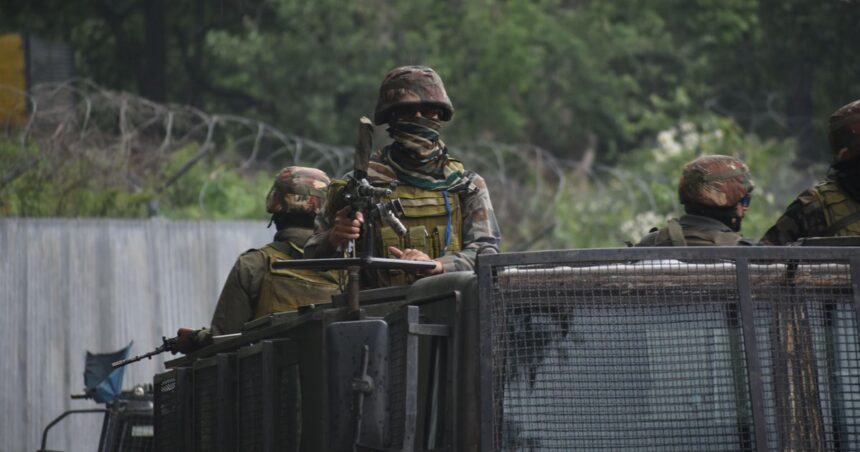New Delhi – TO Mortal terrorist attack In the picturesque pahalgam area of Cashmir War edge. The residents of the southern nuclear armed Asia have attacked each other this week with missiles and drones in a sudden outbreak of a decades that are observed with leaders around the world.
Bitter rivals have fought against three wars on Kashmir in the past, and once again they face any movement that can intensify tension, and promising to respond in the child to any of these movements with a hard military action.
After a week of intense clashes, India and Pakistan accused on Saturday of increasing the crisis by launching drones and air attacks against the military facilities of others.
Pakistani officials have accused India or killing at least 36 people this week, including 26 years, he says he died in a night missile attack in multiple places, Whatich Islamabad labeled a “act of war. “India described these strikes a measured response to April terrorist attack, claiming that he had killed 100 terrorists in camps and other sites in Pakistan and Kashmir administered by Pakistan.
Faisal Khan/Anadolu/Getty
The rivalry between the two countries dates back to decades, and in the heart of the dispute is the impressive mountainous region of Kashmir.
The Kashmir conflict explained
Kashmira is a region of the Himalayas dotted with snowy mountains, pristine lakes and beautiful meadows. Previously it was one of the many “princely states” of India, governed by the so -called maharajas, before India obtained the independence of the British domain in August 1947.
That independence, however, has never pushed a simple matter. While he gave his colonial power, Great Britain divided India into two nations: India of Hindu majority and Muslim majority Pakistan.
The migration of Hindus of the newly carved Pakistan to India, and from the Muslims of India to Pakistan, was fogged by massacres and generalized sectarian violence. The most fatal partition of a nation in contemporary history is considered widely.
At the time of the partition, Kashmiro was a princely state of Muslim majority, and its Hindu Maharaja Hari Singh, decided to remain independent of the two newly defined nations. But in October 1947, when the members of the tribe of Pakistan invaded Kashmir, the Maharaja sought the help of India.
India agreed to go to his aid, but only if Singh let India claim Dominion on Kashmir as a previous condition. The Maharaja agreed.
India sent his army to Kashmira, which expelled the members of the Pakistani tribe and, for all purposes, Kashmira Basa a semi -autonomous part of India.
The wars of India and Pakistan on Kashmir
Pakistan refused to recognize the adhesion of Kashmir to India, dismissing as fraud. The confrontation led the two nations to their first war that same year, and lasted in 1948.
India asked the United Nations to intervene. The UN recommended that, after the complete demilitarity of the region by both armies, Kashmir residents celebrated a vote to determine their future.
That was never achieved, and in 1949, India and Pakistan signed a high -fire agreement that divided very disputed Kashmir into two parts.
Both nations claim every reason as their own territory, but each one controls only part of it. Another northeast of the region is administered by China, which has a long leg of friction between Delhi and Beijing.
In 1965, the tension over the region between India and Pakistan again exploded in a large -scale war. Thousands of people were killed on both sides. Approximately seven years later, an agreement was signed that formally established a control line (LOC) that divided Kashmir, which still serves as the de facto border between the two rivals.
In 1989, a pro-independence insurgency root with a back of the Indian managed, launching mortal attacks against the Indian forces. India has long accused Pakistan of training, armed and support for those militants, a position of Pakistan flatly denies.
The insurgency of three decades has left tens of thousands of dead people.
ZUBAIR ABBASI/Middle East images/Middle East/AFP images
Pakistan has constantly denied accusations that support the separatists of Kashmir.
In 1999, the two countries again participated in a war war, fought along the LOC in northern Kashmir.
They almost went to war again after mortal terror Attack on the commercial capital of India Mumbai In 2008, which was carried out by a militant group based in Cashmiro administered by Pakistan, with, with, with, with, with The alleged Indian authoritiesThe full support of Pakistani security forces.
India eliminated Kashmir’s autonomy in 2019
As the insurgency continued, India maintained a strong military presence in Kashmir, which makes it one of the most militarized areas in the world. The Indian forces have killed hundreds of separatists every year in regular shootings in the LOC and its surroundings, but have not managed to stop the attacks of the militants.
In 2016, whom India said they were based in Pakistan killed 19 Indian soldiers in an attack against the city of Uri. India responded by launching what he called “surgical strikes” in the LOC, aimed at alleged militant bases. Pakistan denied any Indian attacks in their territory.
In 2019, Another attack Blame for the alleged Pakistani gunmen, an Indian military convoy in the Cashmirus pulwama area, killed more than 40 paramilitary forces.
Indian Prime Minister Narendra Modi, furious for the attack, ordered Air attacks Against Pakistan, causing retaliation networks and an aerial dog fight in which an Indian combat plane was shot down.
Reuters
Later that year, the Federal Government of India, under modi, Revoked the special state of KashmirRaising the partial autonomy he had enjoyed since 1947, which gave the region his own Constitution and the main decision -making powers.
The Modi government faced criticism for the way it revoked the autonomy of Kashmir. A day before his government presented and approved the bill in Parliament, the Indian forces launched a great repression in Kashmir. Internet, television and telephone lines closed, and civilians were ordered to remain indoors. The people’s box, including local politicians, was placed under the trial of the house when India flew more paramilitary forces to the region to maintain a blockage of security and information. Some of those restrictions remained in place for more than two years.
Pakistan opposed the move and promised to “exercise all possible options to counteract illegal steps.”
Around the following years, while India continued to reinforce its presence of security in the region, militancy decreased and tourism returned to Kashmir. The Modi government attributed the credit to transform the region of an access point for terrorism, into an access point for tourism.
But last month’s terrorist attack against Indian tourists in Pahalgam changed everything. Once again, one puts the two nations on a war footing, and the world about the risk of another important conflict in Alreamy’s tumultuous times, and between two nations with a long history of animosity and nuclear weapons.







